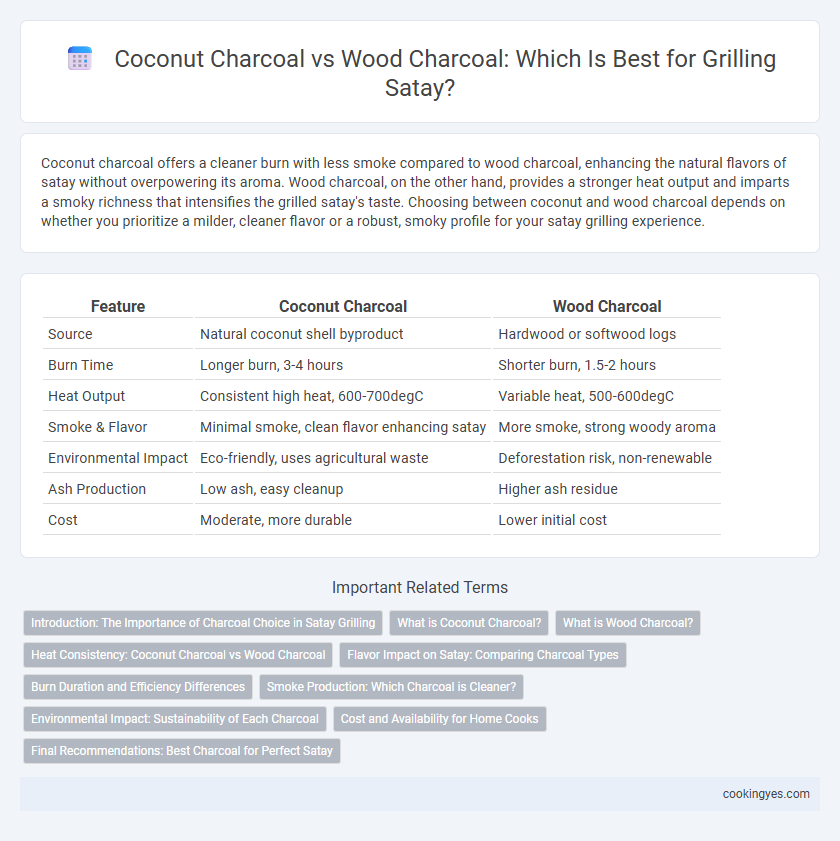Coconut charcoal offers a cleaner burn with less smoke compared to wood charcoal, enhancing the natural flavors of satay without overpowering its aroma. Wood charcoal, on the other hand, provides a stronger heat output and imparts a smoky richness that intensifies the grilled satay's taste. Choosing between coconut and wood charcoal depends on whether you prioritize a milder, cleaner flavor or a robust, smoky profile for your satay grilling experience.
Table of Comparison
| Feature | Coconut Charcoal | Wood Charcoal |
|---|---|---|
| Source | Natural coconut shell byproduct | Hardwood or softwood logs |
| Burn Time | Longer burn, 3-4 hours | Shorter burn, 1.5-2 hours |
| Heat Output | Consistent high heat, 600-700degC | Variable heat, 500-600degC |
| Smoke & Flavor | Minimal smoke, clean flavor enhancing satay | More smoke, strong woody aroma |
| Environmental Impact | Eco-friendly, uses agricultural waste | Deforestation risk, non-renewable |
| Ash Production | Low ash, easy cleanup | Higher ash residue |
| Cost | Moderate, more durable | Lower initial cost |
Introduction: The Importance of Charcoal Choice in Satay Grilling
Coconut charcoal offers consistent high heat and minimal smoke, enhancing the authentic flavor of satay while reducing cooking time. Wood charcoal, while traditional, can produce varying heat levels and more smoke, potentially overpowering the delicate balance of satay spices. Selecting the right charcoal type directly influences grilling efficiency and the overall taste profile of satay.
What is Coconut Charcoal?
Coconut charcoal is a type of natural charcoal made from coconut shells, known for its eco-friendly and sustainable production process. It burns hotter and longer than traditional wood charcoal, producing less smoke and minimal odor, which enhances the authentic flavor of satay without overpowering the spices. This charcoal's consistent heat output and clean burn make it an ideal choice for grilling satay, ensuring evenly cooked meat with a smoky, aromatic finish.
What is Wood Charcoal?
Wood charcoal, derived from burning hardwood in a low-oxygen environment, is prized for its ability to reach high temperatures and impart a natural smoky flavor essential for authentic satay grilling. Unlike coconut charcoal, wood charcoal produces a steady heat with subtle aromatic notes that enhance the marinated meat's flavor complexity. Its porous structure allows for excellent airflow, ensuring consistent combustion and optimal grilling conditions.
Heat Consistency: Coconut Charcoal vs Wood Charcoal
Coconut charcoal provides more consistent, high heat for satay grilling compared to wood charcoal, which often produces fluctuating temperatures. This even heat distribution ensures uniform cooking and enhances the satay's smoky flavor without burning the marinade. As a natural, eco-friendly fuel, coconut charcoal also generates less ash, maintaining stable heat throughout the grilling process.
Flavor Impact on Satay: Comparing Charcoal Types
Coconut charcoal imparts a subtle sweetness and cleaner smoke, enhancing satay's natural flavors without overpowering the marinade. Wood charcoal, depending on the wood type, can introduce robust, smoky, and sometimes resinous notes that add complexity but risk masking delicate spices. Chefs often prefer coconut charcoal for balanced flavor and consistent heat control when grilling traditional satay.
Burn Duration and Efficiency Differences
Coconut charcoal offers a longer burn duration compared to wood charcoal, making it more efficient for extended satay grilling sessions. Its high carbon content ensures steady heat output, reducing the need for frequent refueling. Wood charcoal burns faster but ignites quicker, which may be suitable for short grilling periods but less efficient for consistent satay cooking.
Smoke Production: Which Charcoal is Cleaner?
Coconut charcoal produces significantly less smoke compared to wood charcoal, offering a cleaner grilling experience ideal for satay. Its dense composition allows for a steadier burn with minimal flare-ups and lower emission of volatile organic compounds (VOCs), which contribute to smoke and unpleasant odors. Wood charcoal, on the other hand, tends to emit more smoke and particulate matter due to its resin content, impacting the clarity of satay's flavor during grilling.
Environmental Impact: Sustainability of Each Charcoal
Coconut charcoal is derived from coconut shells, making it a renewable and sustainable resource that reduces waste from the coconut industry, whereas wood charcoal production often involves deforestation and habitat destruction. The carbon footprint of coconut charcoal is generally lower due to its use of agricultural byproducts instead of cutting down trees. Using coconut charcoal for satay grilling promotes environmental sustainability by minimizing deforestation and supporting circular economies in tropical regions.
Cost and Availability for Home Cooks
Coconut charcoal is often more affordable and widely available in tropical regions, making it a cost-effective choice for home cooks grilling satay. Wood charcoal tends to be pricier and less consistent in quality due to variations in wood types, but it is commonly found in general markets worldwide. Availability and price fluctuations depend heavily on local resources, with coconut charcoal providing a sustainable and budget-friendly alternative in coastal areas.
Final Recommendations: Best Charcoal for Perfect Satay
Coconut charcoal offers a cleaner burn with minimal smoke, enhancing the satay's natural flavors without overwhelming them, while wood charcoal delivers a stronger smoky aroma for a more traditional taste. For perfect satay grilling, coconut charcoal is ideal when aiming for subtle, pure meat flavors and a consistent heat source. Choose wood charcoal if you prefer rich, smoky undertones that complement the spices and marinade of classic satay recipes.
Coconut Charcoal vs Wood Charcoal for satay grilling Infographic

 cookingyes.com
cookingyes.com